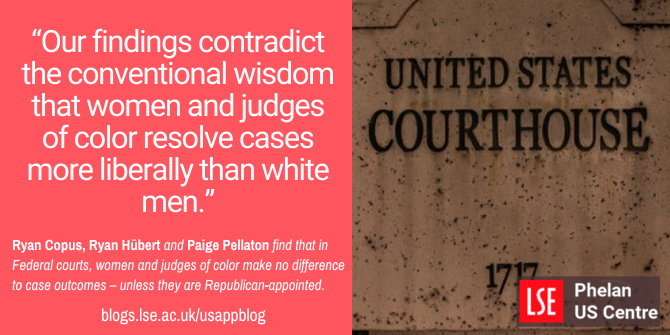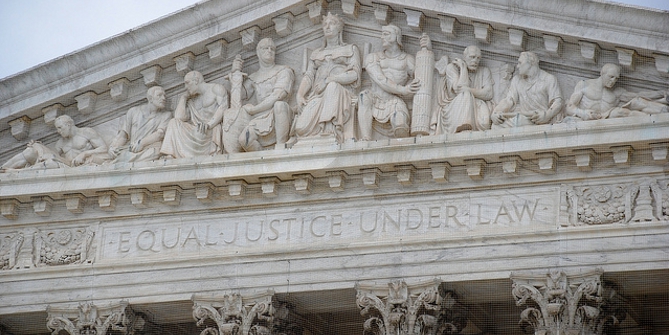

 Historically, the federal judiciary has been dominated by white men. But has the growing diversity of federal courts had an impact on how cases are decided? In new research, Ryan Copus, Ryan Hübert and Paige Pellaton compile an expansive dataset of court cases to study the effects of judicial diversity in federal courts on case outcomes. They find that, contra to previous research, there are no differences between case outcomes between women and judges of color and white male judges appointed by Democrats, but that judges of color and women appointed by Republican presidents saw more conservative outcomes than the white men they appointed.
Historically, the federal judiciary has been dominated by white men. But has the growing diversity of federal courts had an impact on how cases are decided? In new research, Ryan Copus, Ryan Hübert and Paige Pellaton compile an expansive dataset of court cases to study the effects of judicial diversity in federal courts on case outcomes. They find that, contra to previous research, there are no differences between case outcomes between women and judges of color and white male judges appointed by Democrats, but that judges of color and women appointed by Republican presidents saw more conservative outcomes than the white men they appointed.
Many claims are made by observers, activists, and political actors about the impacts of having a diverse set of judges appointed to the US federal courts. One important question is, to what extent do judges from historically underrepresented racial, ethnic or gender backgrounds approach cases differently than the white men who have traditionally been appointed to serve as federal judges? Notwithstanding a handful of exceptions, the conventional wisdom that has emerged from research on this topic is that women and judges of color resolve cases in a more liberal manner, at least in some areas of law that are relevant to identity.
The limits of existing research on judicial diversity and case outcomes
While this body of research is both important and influential, we argue that it is insufficient for drawing confident conclusions about whether female judges and judges of color resolve cases differently than the white men who have traditionally been appointed to the federal courts. First, researchers have paid much less attention to the lowest courts in the federal judiciary (called “district courts”), where most judges are seated, including most women and judges of color. This is a problem because district courts are the workhorses of the federal judiciary, providing final resolution for more than 90 percent of federal lawsuits. Indeed, as US District Judge Henry N. Graven once famously said, “The people of this district either get justice here with me or they don’t get it at all”. Second, past research has taken an analytical approach that we argue limits what kinds of conclusions we can draw about the impacts of judicial diversity.
We wade into this debate by collecting and analyzing an original dataset of all civil rights cases filed in twenty US federal district courts from 1995 to 2020, totaling around 260,000 cases heard by 545 federal judges. The twenty district courts in our dataset are among the largest and most impactful in the US (covering, for example, New York City, Los Angeles, and Chicago). Combined, they have jurisdiction over 40 percent of the US population, seat 40 percent of the federal district judges, and resolve 40 percent of federal civil rights lawsuits. This is the most expansive dataset of court cases that scholars have marshaled to study judicial diversity in federal courts.
Focusing on civil rights lawsuits to test case outcomes.
We focus on civil rights lawsuits because it is one of the areas of US federal law which has had the greatest impact. Many of the cases in our dataset were brought under some of the nation’s landmark civil rights laws, such as the Civil Rights Act of 1964 and the Americans with Disabilities Act of 1990. At a more practical level, civil rights cases have been the focus of many prior studies on judicial diversity, and they also allow for more straightforward interpretations of effects in ideological terms: on average, outcomes favoring plaintiffs are “liberal” and outcomes favoring defendants are “conservative.” We use the phrases “liberal” and “conservative” in the standard American sense, meaning “left-wing” and “right-wing” respectively.
Republican-appointed judges of color and women make a difference to case outcomes.
We statistically test whether the judges of color and women appointed by presidents of each party, whom we collectively term “nontraditional appointees,” cause different case outcomes relative to the white men appointed by presidents of the same party, whom we term “traditional appointees.” We find no differences in average outcomes between cases assigned to nontraditional Democratic appointees and cases assigned to traditional Democratic appointees. On the other hand, nontraditional Republican appointees cause fewer settlements than traditional Republican appointees, by approximately 2.2 percentage points, and more defendant wins, by approximately 1.2 percentage points. A supplemental analysis of a nationally representative dataset of civil rights cases filed in 2016 and 2017 yields a similar result.

“U.S. District Court 17” (CC BY-NC 2.0) by davidseibold
We interpret these results as evidence that the judges of color and women appointed by Republican presidents caused more conservative outcomes on average than the white men those Republican presidents appointed. For added context, these within-party differences among Republican appointees are slightly larger than the partisan differences we estimate between Republican appointees and Democratic appointees. On the other hand, we interpret the lack of differences among Democratic appointees of different races and/or genders to indicate that there are no substantial ideological differences among Democratic appointees of different races and/or genders. We do not find any evidence that the findings for judges from either party are driven by specific subgroups of nontraditional appointees, such as women, judges of color, Black judges, etc.
We also test whether types of plaintiffs benefit when their cases are assigned to a nontraditional appointee. Indeed, a commonly made claim is that judges of color will generate more favorable outcomes for people of color and women judges will generate more favorable outcomes for women. We examine this issue by looking to see if judges of color and women judges cause different outcomes in cases filed by plaintiffs of color and women plaintiffs, respectively. We find no evidence of substantial differences.
Trading diversity between political parties
In multiple ways, our findings contradict the conventional wisdom that women and judges of color resolve cases more liberally than white men. While we believe that our results are especially robust and trustworthy, what could possibly explain the apparent difference between the appointees of the two parties? All federal judges go through a specific process to be seated as judges: they are nominated by the President and then confirmed by the Senate. Practically speaking, this means that the judges in our dataset only ended up on the bench because of political bargaining between the Democratic and Republican parties.
We argue that the empirical pattern we found is consistent with a theory of political bargaining in which Republican politicians place little importance on diversity while Democratic politicians do. According to the theory, this kind of lopsidedness in the preferences between the two parties allows Republican presidents to exploit Democratic preferences for diversity to (at least partially) overcome Democratic opposition to Republican presidents nominating more conservative judges. We call this “trading diversity.”
- This article is based on the pre-print, ‘Trading Diversity? Judicial Diversity and Case Outcomes in Federal Courts’.
- Please read our comments policy before commenting.
- Note: This article gives the views of the author, and not the position of USAPP – American Politics and Policy, nor the London School of Economics.
- Shortened URL for this post: https://bit.ly/3RScefu






